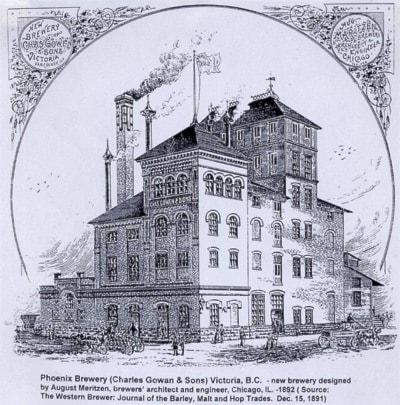In 1858, the Fraser River gold rush drew thousands of fortune seekers to Victoria, bringing the population up from 300 to thousands overnight — one with a thirst for beer.
“Victoria was always a city that embraced alcohol,” says beer historian Greg Evans. “People have this image of a quiet, quaint city, but when you do the research, you realize that the opposite was true. Prior to 1891, there were no laws in B.C. Stipulating the opening and closing hours of saloons. The bars in Victoria could be open 24 hours a day, seven days a week.”
Because of the mining, logging, fishing and whaling, Victoria always had a large transient population. The population would swell in the winter when those industries had down time and the workers would come to town to indulge.
“Breweries have always done well when the economy isn’t,” says Evans. “It was a town of drinkers then, and it still is.”
1858-1916
William Steinberger from Cologne, Germany was one of the many who came to Victoria in search of an amazing fortune. He opened Victoria’s first brewery, Victoria Brewery, at Swan Lake that year, making him the first Canadian commercial brewer west of the Great Lakes. The brewery moved to the corner of Discovery and Government the next year to be closer to the action.
In 1859 the Colonial Brewery opened on Johnson Street. Two years later, the Halfway House opened in Esquimalt, on the land that later housed the Esquimalt Inn.
Fernwood's first brewery was established in 1862 when Lion Brewing opened on Spring Ridge, on the land that is now the playground for George Jay Elementary.
The Bavaria Brewery opened in 1863 on Fort Street between Blanshard and Quadra. The same year, James Bay Brewery opened on Michigan Street.
Phoenix Brewery opened in 1868 on the corner of Yates and Blanshard.
The Garrick’s Head Saloon originally opened on Dec. 31, 1867. “It was owned at that time by Mr. Thomas Chadwick, who previously owned the International Hotel on Yates Street. It was related that he spared no expense in ornamenting the saloon, which was described as one of the prettiest in the colony,” says Evans.
The Carter Brothers Brewery opened in 1883 on the 500 block of Herald Street. Three years later, they would gain considerable fame when they received “medals for the display and superior quality of their ale and porter from the Paris Exposition, the Colonial and Indian Exposition and the British Columbia Agricultural Association; the one received from the Paris Exposition being a handsome one of solid gold.”
At that time, the Canadian Pacfic Railway didn't extend this far west and the Panama Canal wasn’t built. The Carters would have had to ship their beer across the country to the Atlantic before sending it across the ocean by ship to Europe, all while keeping their brew cold — an amazing feat.
Fort Street got another brewery in 1884 when Tiger Brewery opened its doors. It was later renamed City Brewery. Pacific Brewery joined the Carter Bros. on Herald Street in 1885, but it burned to the ground that same year.
Fernwood got its second brewery in 1885 when Empire Brewery opened at Spring Ridge. Peter Henning Peters, a German who came to Victoria via San Francisco opened the brewery but died in 1886, leaving his wife Alvina to manage the brewery. Alvina would have likely been the first female brewery manager in Western Canada. Empire also burned down in 1887.
The E&N Brewery opened on the corner of Catherine and Esquimalt in Vic West in 1888.
The Royal Commission On The Liquor Traffic was published in 1896. The commission travelled across the country investigating the conduct of the liquor trade, recommended regulations and calculated what might be the consequences of prohibition.
Victoria's second Lion Brewery opened in 1901 on the 800 block of View Street.
Vic West got its second brewery in 1902 when Silver Springs was built.
Esquimalt Brewery opened in 1914 on the 800 block of Viewfield Road. It burned down two years later.
1917-1921 Prohibition
On Oct.1, 1917 prohibition went into effect and the taps all went dry— except for near beer (less than 2.5%).Liquor was available by prescription from a doctor, but that system led to abuse. This time also gave rise to bootleggersand private stills.
Prohibition was eventually voted down by a huge margin, making way for the government controlled liquor distribution system we know today. M
Greg Evans is a beer historian in Victoria. His work will be featured in the Royal B.C. Museum’s new book Feeding the Family. He wrote the chapter called “The Beer Brewers.” It will be released in late June.
For more information about Victoria’s beer history or to book Evans for a beer tasting workshop, public speaking event, or to book a spot on his beer tours, email brewersgold@shaw.ca
